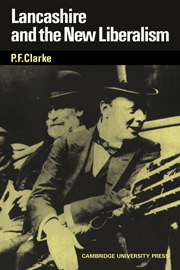Book contents
- Frontmatter
- Contents
- Preface
- Abbreviations
- Dedication
- PART ONE INTRODUCTION
- PART TWO FORMATIVE INFLUENCES
- 2 Manchester School to Tory Democracy
- 3 The Conservative Party at prayer
- 4 Cotton
- PART THREE THE TERMS OF THE CONTEST
- PART FOUR THE RECONSTITUTION OF LIBERAL LANCASHIRE
- PART FIVE FIELDS OF RECRUITMENT
- PART SIX GOING TO THE COUNTRY
- PART SEVEN CONCLUSION
- APPENDICES
- Bibliography
- Index
3 - The Conservative Party at prayer
Published online by Cambridge University Press: 23 November 2009
- Frontmatter
- Contents
- Preface
- Abbreviations
- Dedication
- PART ONE INTRODUCTION
- PART TWO FORMATIVE INFLUENCES
- 2 Manchester School to Tory Democracy
- 3 The Conservative Party at prayer
- 4 Cotton
- PART THREE THE TERMS OF THE CONTEST
- PART FOUR THE RECONSTITUTION OF LIBERAL LANCASHIRE
- PART FIVE FIELDS OF RECRUITMENT
- PART SIX GOING TO THE COUNTRY
- PART SEVEN CONCLUSION
- APPENDICES
- Bibliography
- Index
Summary
I do not like that which I find is the accepted maxim in Lancashire, that every Churchman is a Conservative and every Nonconformist a Liberal.
Bishop FraserIn the north west, religion was probably associated with politics even more closely than in other parts of Britain. It is less likely that, when the operatives became voters in 1867 and 1884, they often moved naturally into the Conservative ambit because the Liberals were the bosses' party, than that a large section of the working class were exhibiting Anglican reflexes against Liberal Nonconformity. In its appeal to the urban masses, Lancashire Churchmanship ran a strait and narrow course between the Dissent of the bosses and the Roman Catholicism of the Irish immigrants. It was the strain of fighting Evangelical Anglicanism thus defined which was the peculiar factor in the Conservatives' electoral strength in the region.
It is only necessary to compare Victorian England with the secular society which emerged from it to see that in social terms the nineteenth century was an age of faith. When religious feeling reinforced political allegiance it enshrined a pattern of behaviour which was often broken only by a twofold – or manifold – transfer of allegiance. Two figures mentioned previously exemplify this. W. Romaine Callendar, the eminent Conservative and Churchman, came from a family that was Liberal and Nonconformist; W. Farrer Ecroyd was brought up as a Quaker and a Liberal, but became a Churchman and a Protectionist M.P. It may be that all political behaviour is rooted to an extent far greater than is at first apparent in a complex of habitual responses.
- Type
- Chapter
- Information
- Lancashire and the New Liberalism , pp. 53 - 75Publisher: Cambridge University PressPrint publication year: 1971



